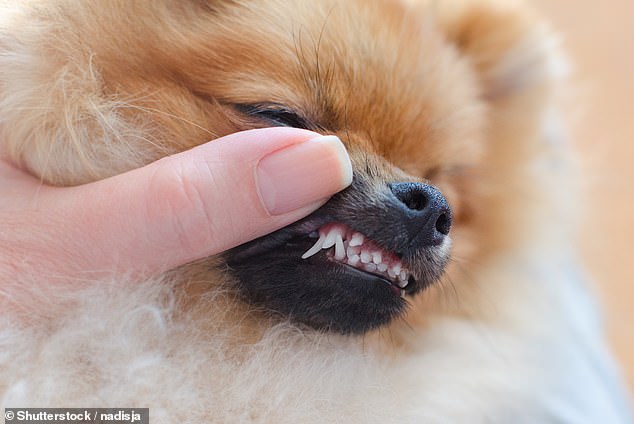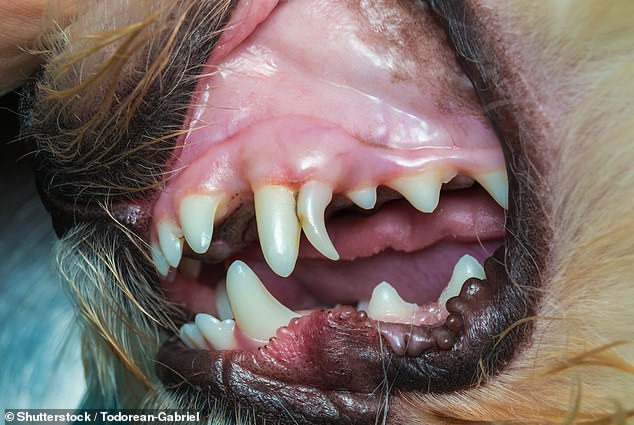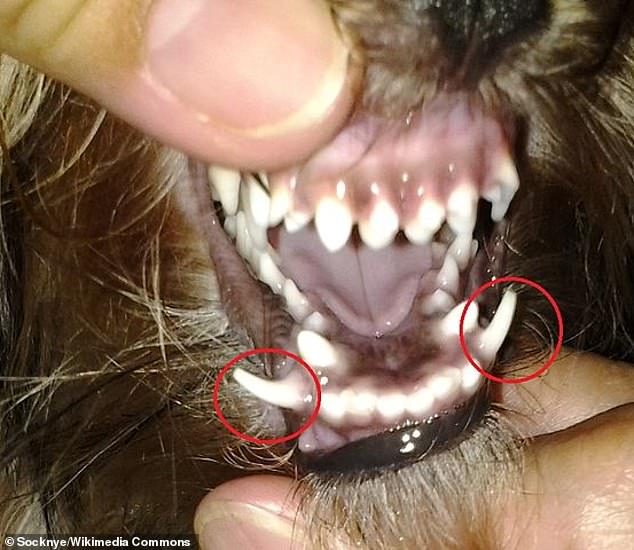Table of Contents
Dog owners have been urged to keep an eye out for a little-known dental condition that affects seven per cent of canines.
‘Shark teeth’, officially known as persistent deciduous teeth (PDT), is a disorder in which two sets of grinding teeth protrude from a row of gums.
It occurs when a dog’s baby teeth remain fixed in the jaw instead of falling out when the permanent teeth emerge.
According to veterinarians in a new study, the dog breed most likely to suffer from PDT is the Yorkshire terrier, followed by the toy poodle, Maltese and Chihuahua.
PDT can cause a misaligned bite (“malocclusion”), which can cause the mouth to bleed, as well as an increased risk of periodontal disease, a serious gum infection.
‘Shark teeth’, officially known as persistent deciduous teeth (PDT), is a disorder in which there are two sets of grinding teeth protruding from a row of gums. The baby fangs retained by this dog are surrounded in red. Both lower permanent fangs did not grow just below the baby’s fangs.
The new study was led by Corrin Wallis, a research scientist at Waltham Petcare Science Institute in Leicestershire.
“Dogs use their teeth for a multitude of tasks and, as such, it is vital to their health and well-being to maintain their oral health,” say Wallis and colleagues.
“Persistent primary teeth (PDT), those that do not fall out at the appropriate time, are associated with malocclusion (misaligned bite), soft tissue trauma, and an increased risk of periodontal disease.”
For the study, the team examined the medical records of 2.8 million dogs in the US over a five-year period, from January 2010 to December 2014.
The dogs were separated into groups based on their weight, from extra small breeds (weighing less than 6.5 kg) to extra large breeds (over 40 kg).
Overall, among all weight groups, the prevalence of PDT according to the dogs’ medical records was seven percent.
In terms of individual breeds, Yorkshire terriers had the highest prevalence of PDT (25.1 percent), followed by the Maltese and toy poodle (both at 14.8 percent).
Meanwhile, the greyhound had the lowest prevalence, at 0.1 percent, followed by the Rhodesian Ridgeback (0.2 percent).

PDT can cause a misaligned bite (“malocclusion”), which can cause the mouth to bleed, as well as an increased risk of periodontal disease, a serious gum infection.
Great Danes, English bulldogs and boxers also showed a low prevalence of the condition (all at 0.4 percent).
In general, the prevalence of PDT was found to be higher as breed size decreased.
In total, 15 percent of extra-small dogs had PDT, while less than one percent of all dogs in all categories weighing more than 15 kg had this condition.
It’s not clear exactly why smaller breeds are more prone to PDT, but it could have a genetic basis.
Like humans, dogs have two sets of teeth throughout their lives: 28 temporary (baby) teeth and 42 permanent (adult) teeth.
A dog’s baby teeth begin to emerge between three and six weeks of age and usually fall out by six months of age.
At around three to five months of age, permanent teeth begin to appear.
When a permanent tooth follows a natural eruption path, it puts pressure on the top of the baby tooth.
“However, an incorrect eruption trajectory of the permanent successor tooth or its complete absence can disrupt this resorption process and lead to PDT,” the authors state.
Shark teeth were also 11 percent more common in overweight dogs, although researchers aren’t sure why.

Like humans, dogs have two sets of teeth throughout their lives: 28 temporary (baby) teeth and permanent (adult) teeth of 42 teeth.
The team wants owners of small and extra small breeds to be aware of the importance of regular veterinary check-ups that include an oral examination.
They say it’s especially important for smaller breeds to have a thorough oral exam around six months of age to identify and eliminate any PDT.
“Once identified, PDT can be eliminated and, if performed before six months of age, the chances of problems associated with PDT, such as the development of periodontal disease or malocclusion, are likely to be greatly reduced,” they write.
The new study has been published in the journal Research in Veterinary Sciences.

